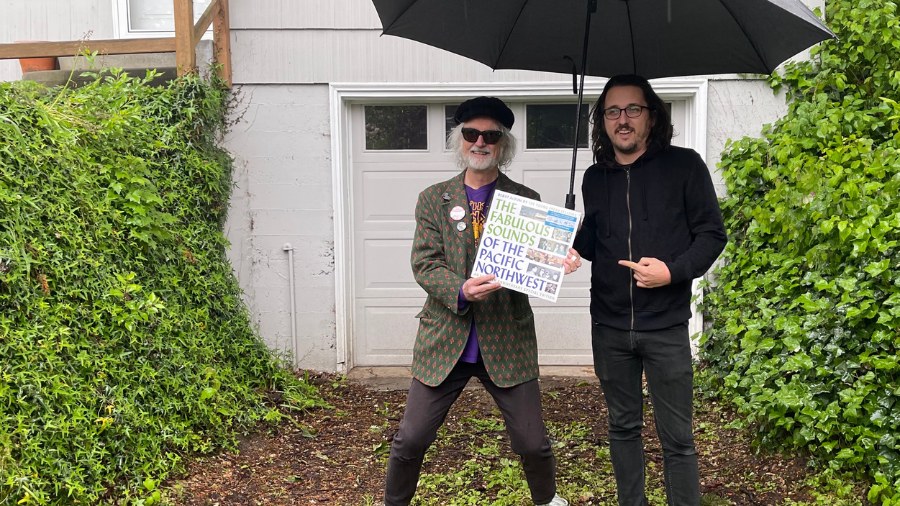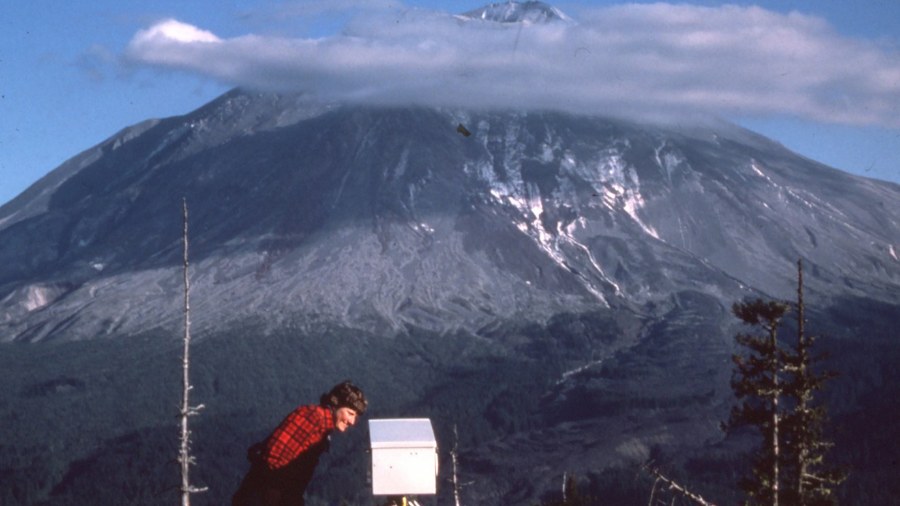Solving the 1870s photo mystery of Lake Washington coal shipping
Jun 21, 2023, 9:46 AM

A pair of images of a giant lakeside "incline" built in the 19th century for moving coal to barges; annotations show matching trees which helped correctly identify a pair of photos in the collection of the Eastside Heritage Center as being from Lake Whatcom and not from Lake Washington. (Courtesy Clay Eals and Jean Sherrard; original images from Eastside Heritage Center and Whatcom Museum)
(Courtesy Clay Eals and Jean Sherrard; original images from Eastside Heritage Center and Whatcom Museum)
Local history can sometimes be a “local mystery.” And occasionally, one possible explanation for some aspect of local history gets turned on its head when new information appears.
That’s the case with a pair of vintage photographs which a group on the Eastside believed showed part of a major coal mining operation on the shores of Lake Washington 150 years ago.
More from Feliks Banel: Seattle man was a key figure in the airship era
This story was first shared on Paul Dorpat’s Now & Then blog by Clay Eals and Jean Sherrard, who write the weekly Now & Then column for the Seattle Times and who are both good friends of Seattle’s Morning News.
Eals and Sherrard gave their permission to tell this story on the radio. Their cooperation, and the story itself, say a lot about what motivates amateur historians and other volunteer sleuths to look into otherwise overlooked stories, and it says a lot about collaboration (and, when necessary, humility) in the Pacific Northwest heritage community.
It was back in the 1870s when coal was being mined in what’s now the Eastside suburbs east of Lake Washington near what’s now Newport and Newcastle. Many of the mines were located in what’s now King County’s Cougar Mountain Regional Wildland Park near Newcastle. Extracting coal was one of the first large-scale industrial undertakings in this area, ahead of even large-scale timber extraction in many ways.
The outfit doing the work was called the Seattle Coal and Transportation Company. The coal they were extracting from Newcastle was being sold as far away as San Francisco – but it took a complex system just to get the coal to the waterfront to be loaded on ships in Elliott Bay at the foot of Pike Street.
In those long-ago days before the Montlake Cut, the transportation effort required barges on Lake Washington; a short “portage railroad” from Union Bay on Lake Washington to Portage Bay on Lake Union; barges on Lake Union from Portage Bay to roughly where MOHAI now stands; and then the city’s first railroad along what’s now Westlake Avenue.
Harry Dursch lives in the Newport area south of Bellevue and is a member of the Newcastle Historical Society and co-author of a book about the history of coal mining in that area. He’s also part of an ad hoc group of historians who’ve been studying the coal industry on Lake Washington for many years.
“They’d load [the coal] up on trams and bring it down to the top of where the Newport Hills shopping center is, plus or minus,” Dursch told KIRO Newsradio. Then, they’d “lower down this incline to Lake Washington, where they built a very significant pier, and they would load it onto a barge and ship it over to the Montlake Cut area. And the journey began.”
And what a journey, says Harry Dursch. It was laborious, as well as time and resource-intensive.
“We think the coal was handled almost 13 times by the time it got from the ground to the customer in San Francisco,” Dursch said.
About the “incline to Lake Washington” that Dursch mentioned: That’s a pretty serious piece of infrastructure, a giant wooden trestle about 1,200 feet long, critical to get the coal from the hillside above the lake down to lake level to load onto barges. The incline, easily the most complex and intriguing part of the entire operation, is what’s shown in the pair of vintage photos.
The photos are from the collection of the Eastside Heritage Center. They were donated by a local family about 30 years ago – though the family kept the originals and allowed Eastside Heritage Center to make duplicates.
Kent Sullivan is a railroad historian who’s also a member of the Lake Washington coal research group. He told KIRO Newsradio the photos show the scope and scale, and basic operation, of the massive incline structure.
“You’re using railroad rails and railroad-type cars, but you’re lowering the car or cars or pulling them up using some sort of cable or winch,” Sullivan said. “And that’s what you see in these photos. It’s clearly not finished, but it looks close to being done. And if you zoom in on both of them, you can see that there is a work crew about a third of the way down the incline doing something.”
To hear Harry Dursch and Kent Sullivan tell it, the two photos now almost seem like the “Shroud of Turin.” The images were foundational to so much of what they had come to believe about the incline on Lake Washington, and they had found their way into the group’s writings and presentations and to a Seattle Times Now & Then column published in 2019.
Even a quick glimpse tells the casual observer that there’s no denying that the photos are amazing evidence of a once-major industry around here that’s been mostly forgotten.
But then, somebody else saw the images and had a different idea.
The incline photos were part of a presentation given by a staff member of the Eastside Heritage Center for Bellevue College back in 2020. A retired Boeing engineer named Andy Valaas saw that presentation.
Valaas told KIRO Newsradio he doesn’t typically spend a lot of time thinking about local history – but he had commuted between Bellevue and Renton for years, driving right past that particular stretch of Lake Washington in question – where an incline once stood – thousands of times.
When he saw the photos, Andy Valaas immediately knew something was not quite right.
“I looked at the picture and said to myself, ‘There’s no way that can be Lake Washington,’” Valaas said.
So, later that same day back in 2020, Valaas emailed the Newcastle Historical Society about his concerns. But that wasn’t all. In his email, he also wrote that he had already identified the place he thought the photos actually showed: Lake Whatcom near Bellingham and an incline built in the 1890s for something called the Blue Canyon Mine.
Zeroing in on Lake Whatcom wasn’t some random stroke of luck. Valaas had remembered seeing an old photo of coal cars on a barge on Lake Whatcom – which, he thought, meant there was probably an incline somewhere on that lake, too. He used Google Earth to confirm that the landscape in the old photos matched present-day Lake Whatcom.
Harry Dursch and Kent Sullivan read Andy’s email and, to their credit, took his theory seriously. They tracked down photos of the Blue Canyon incline at Lake Whatcom in the collection of the Whatcom Museum in Bellingham.
Dursch and Sullivan say it was four otherwise innocent trees that are visible in the Whatcom Museum photo – which are also visible in what they thought were Lake Washington photos – that convinced them Andy Valaas was right.
“When you look at trees A, B, C, and D, they overlap all the images,” Dursch said, referring to a now-annotated image identifying the quartet of distinctive trees. “And that was, to me, that was the slam dunk – those four trees.”
“Yeah, especially the one with the U-shaped branches at the top,” Sullivan chimed in. “There’s just no way that’s going to be a duplicate somewhere else.”
Apart from the record being corrected and the mystery being solved, what’s most remarkable about this story is how candid and transparent Harry Dursch, Kent Sullivan, and Matt McCauley (Sullivan and McCauley together wrote the blog post for Now & Then) are about what it was like to have Andy Valaas essentially reset their historical reality on a years-long project.
Harry Dursch acknowledges it wasn’t easy. The process, he says, almost felt like grieving.
“I don’t think the three of us will ever forget that month-long transition from denial to acceptance,” Dursch said. “It was pitchers of beer, and anger and frustration and disappointment, and then acceptance that Andy was right, and this is the way history unfolds.”
Matt McCauley is the third member of the group interviewed for this story who’s also a good friend of Seattle’s Morning News. McCauley was also very candid about how tough it was being corrected.
“So this was very painful, this whole process,” McCauley told KIRO Newsradio. “But you reach a point where you can’t keep lying to yourself, where truth has to prevail. And you have to say, ‘Oh, no, I was so invested in this.’”
“But you know, truth is truth,” McCauley said.
And that’s part of the reason why McCauley and Sullivan wanted to write about their experience for the Now & Then blog, and not simply pretend nothing had happened and hope no one noticed.
“There was no question that we wanted to set the record straight,” Kent Sullivan said. “[And] it seemed like a ‘teaching moment’ you wouldn’t want to pass up about how history works.”
McCauley, who’s been searching and researching Lake Washington for decades and who is involved with other notable history projects, says he ultimately had to go up to Lake Whatcom in person to see for himself.
“A lot of it was getting up to as much elevation as I could at that Blue Canyon area and looking across the mountains and looking at the angle and slope and realizing this is nothing,” McCauley said. “This is not it, and that’s not in the picture. That’s not Mercer Island.”
“There’s no question once you actually get up there and start looking around,” McCauley said.
Harry Dursch says the Lake Washington incline fell out of use when they started shipping coal via rail through Renton in 1878. With Valaas re-identifying the images, this means that as of now, there are currently no known photos of the Lake Washington incline.
Meanwhile, Andy Valaas says he has another photo research project sitting in his in-box for a friend who recently published a vintage image that she now believes was misidentified as Snoqualmie Pass.
If this is a new calling for Andy Valaas and if he wants to make historic image debunking a serious pursuit, KIRO Newsradio and MyNorthwest could easily put the call for more photo mysteries that need solving.
“No. Heavens no,” Valaas said. “I have too many other things to do.”
You can hear Feliks every Wednesday and Friday morning on Seattle’s Morning News with Dave Ross and Colleen O’Brien, read more from him here, and subscribe to The Resident Historian Podcast here. If you have a story idea, please email Feliks here.













